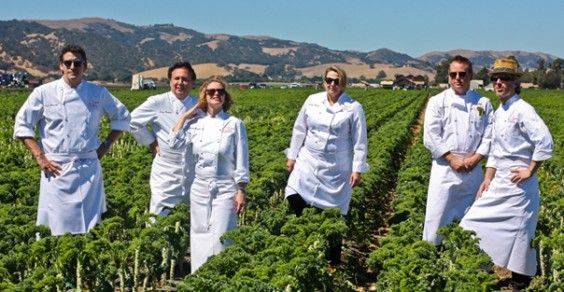It’s easy to stroll down the frozen food aisle and select whichever boxed meal happens to stand out. Maybe it’s a classic mac and cheese one day, an organic enchilada plate the next, or that occasional craving for a pizza that claims to be better than delivery.
If you’re like me, you probably won’t consider where this meal came from, or, if you do, you might assume its birthplace was some far-off conveyor belt. If you’re like me, you’ll grab the cheapest item in the freezer, bring it home, and stash it in the freezer, leaving it forgotten until a grumbling stomach calls for a quick, easy meal weeks later.
Human hands may have never touched what’s inside that box. But those individual components come from somewhere. The cheese, the noodles, the perfectly chopped veggies? For those items, the origin story starts before the assembly depot. Just like any vegetable bought at the grocery store, chopped, and cooked at home, those frozen vegetables, like the ones featured in Lean Cuisine meals, grew at a farm somewhere. And I wanted to find out where.
Last month, I was given the opportunity to travel to Napa, California, on a trip hosted by Lean Cuisine. The focus of the trip was to work with their Culinary Roundtable — food experts from across the company — to learn more about how Lean Cuisine develops recipes, identifies trends, and ultimately serves their customers. I spent two days with members of the culinary, marketing, product development, and food science teams from Lean Cuisine, as well as their five Culinary Roundtable chefs (more on those stars here). The Roundtable Chefs conceive creative dishes that, if all goes according to plan, will transform into Lean Cuisine products in the following months and years. As someone who can’t actually eat any of the Lean Cuisine items due to a gluten intolerance, the trip wasn’t about flavor or variety — it was about discovering whether or not these meals fit well into a healthy lifestyle.
Farm Hands
We visited one of Lean Cuisine’s providers, George Chiala Farms, to discover the roots of the products. This is where all those little elements come from, I thought. An actual person (most likely a handful of people) does touch at least a part of each product before the completed meals make it to the freezer aisle.
We toured the Chiala Farms processing plant where they chop, freeze, roast, purée, and dehydrate all sorts of fresh produce (garlic, peppers, chilies, and kale just to name a few). We watched machines peel and puree thousands of pounds of garlic; we saw workers pick over red pepper pieces before they were roasted, blended, and bucketed as roasted red pepper purée. We even peeked inside an IQF (individually quick frozen) machine as teeny tiny chopped green chilies were rolling through.
So what was this “fresh produce only” girl’s take on those “super processed” frozen vegetables? Well, I hate to admit this but they’re not so processed after all. When those vegetables left the farm on their way to the Lean Cuisine factory, they were as fresh as when they were picked. But while the Lean Cuisine and Chiala Farms teams were pointing out just how pure these items were, I couldn’t help but thinking “Yeah, but what happens to all this stuff when it’s put into a meal?”
Talking Nutrition

The next day, I got my answers. Sort of. Sitting down with Lucien Vendôme, the Director of Culinary Innovations at Nestlé Prepared Foods (which owns Lean Cuisine), and the rest of the Lean Cuisine team, we got a glimpse into how each meal is conceived and created from brainstorming to execution. To create new meals, the Lean Cuisine’s culinary team and Roundtable Chefs create a perfect version of the dish. It’s the technical team’s job to translate that gold-standard dish into something that will work with commercial-grade ingredients and will freeze and reheat without killing the integrity of the food.
When we got to talking more about the ingredients and processing of the products, I pushed them a bit on their claims of “no preservatives.” True, there are no preservatives in any of their dishes — “the freezing is the preserving,” is how many explain the process — but that doesn’t mean the meals are completely clean. I found maltodextrin, caramel color, and other unnecessary additives hiding on some Lean Cuisine labels. I was told by the brand’s reps that all their dishes were free of coloring and preservatives. So why have caramel color on one chicken-based meal? The coloring helps microwaved chicken look more appetizing. Is it going to kill us? Probably not, (unless you’re consuming thousands of milligrams of this stuff per day, which is nearly impossible). But many customers, myself included, would prefer it not be there.
The ingredient list on most Lean Cuisine products is still long, partly due to how many elements go into every dish. They’re aware that their products aren’t perfect yet. The company has already taken many steps to reduce the list of ingredients and to introduce healthy options and interesting new ingredients (Kale was definitely not a featured ingredient 10 years ago). It’s a slow process — especially when the customer desires are constantly changing.
Regardless of the ingredient lists or manufacturing process, each dish does adhere to some pretty strict nutritional guidelines: Each meal contains no more than 333 calories and 9g of fat. The average Lean Cuisine dish contains 650 mg of sodium per portion. (As part of their initiative to reduce sodium levels across all of their products, Nestlé has set a rule for itself that no one meal may contain more than one third of the recommended daily amount of sodium.) Combine any of those boxed options with a fresh side salad and a little healthy dressing, and you’ll have a pretty well-rounded full meal. Is it the healthiest option out there? Of course not. There are always healthier options than any frozen meal, but Lean Cuisine could be a good option a few times per week, especially for those with a busy lifestyle. (It’s certainly healthier than some very popular quick service options found on every corner.)
Frozen Food Convert? Not Just Yet
After going behind the scenes at Lean Cuisine, am I frozen food-only convert? Of course not. I don’t think anyone is. But frozen meals, and Lean Cuisine in particular, do have their place. While this trip opened the door, it left me even more curious to see the rest of the process.
As far as flavor, in an office-wide taste test of four meals, there were some hits (chicken enchilada and spring rolls) and misses (the chicken fried rice left something to be desired). But the truth is that at least two members of our team are fans of the brand, and at least a few others were pleasantly surprised by one or two of the items they tried. Of course, there are still steadfast critics, too.
One thing’s for sure: I’ll no longer grab a frozen boxed meal and just assume each of its elements originated in a factory. The biggest takeaway was that the people who make Nestlé foods (and probably most other packaged products) actually do care about quality. The people I met on this trip with Lean Cuisine — from the PR reps, to the food scientists, to the culinary team and Culinary Roundtable chefs — are passionate about what they do. That trumped any brand-promoting guise.
Disclosure: Travel, accommodations, and all other arrangements to attend the Lean Cuisine Culinary Roundtable were paid in full by Lean Cuisine. As with all Greatist stories, any content we publish is independently written and never in exchange for goods or services.
For “foodies” especially, frozen food can be a tough subject. What’s your take on these convenience items? Must-have, or never-touch? Talk about it in the comments below, or tweet Kate at @ksmorin.

